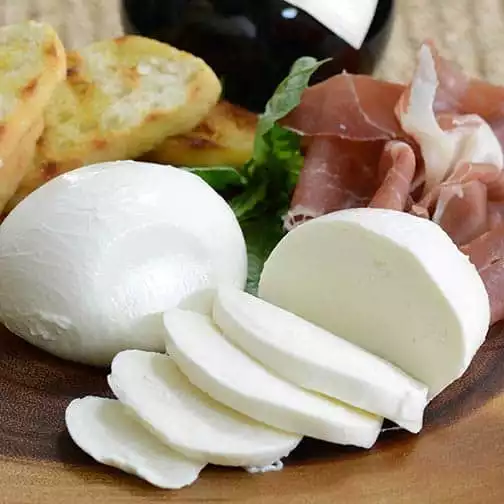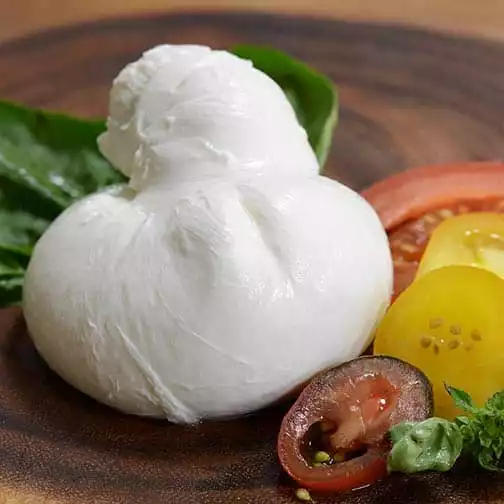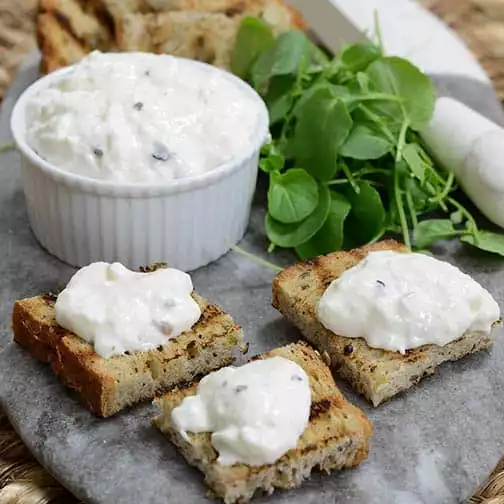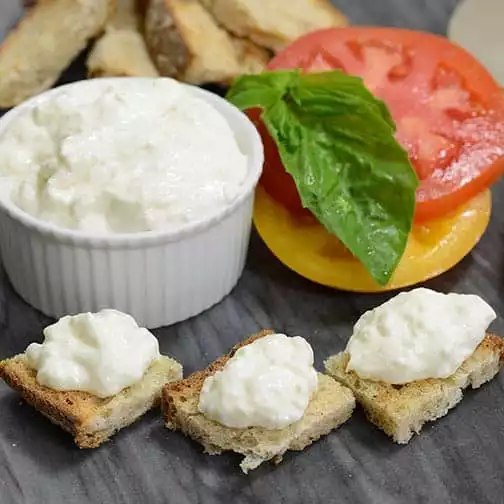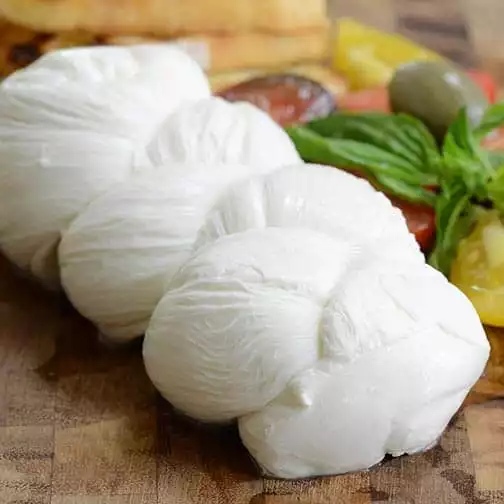Are you wondering how to choose cheese for pizza?
There is something about a melty and stretchy cheese pull that makes pizza one of the most loved dishes in the world.
But how do you choose the best? In short, we use the type of cheese depending on our desired taste and flavor.
The cheese you decide to use can make or break a pizza. You can add flavor and texture depending on what direction you want to go.
However, a few standards can help us select the most suitable cheese for your pizza, and soon you will be PRO on how to choose cheese for pizza.
Let’s check it out!
Here’s What You Will Find:
Key Takeaways
How to Choose Cheese for Pizza
Balance flavors and textures: Select a combination of cheeses that offer a harmonious blend of flavors and textures, ensuring that no single cheese overpowers the others and that the cheeses melt well together.
Complement toppings: Choose cheeses that enhance the flavors of your pizza toppings, creating a well-rounded taste profile that highlights each ingredient’s unique characteristics.
Avoid unsuitable cheeses: Steer clear of extremely hard, crumbly, or liquidy cheeses, as they may not melt properly or could negatively impact the overall flavor and texture of your pizza.
Mozzarella reigns supreme: While there are many kinds of cheese to choose from, Mozzarella is widely considered the best cheese for pizza due to its mild flavor, excellent stretchiness, and meltability, making it a versatile and crowd-pleasing option.
What makes a pizza so good?
How to choose cheese for pizza when you have so many options?
The answers can vary per flavor, but cheese is one of the key ingredients to the quality of a pizza.
There are various types of cheese, and there is no “one size fits all” kind. We must understand what dishes best fit a specific kind, or we might be disappointed with the final product.
Before deciding on how to choose cheese for pizza, it’s essential to understand what makes each type of cheese unique.
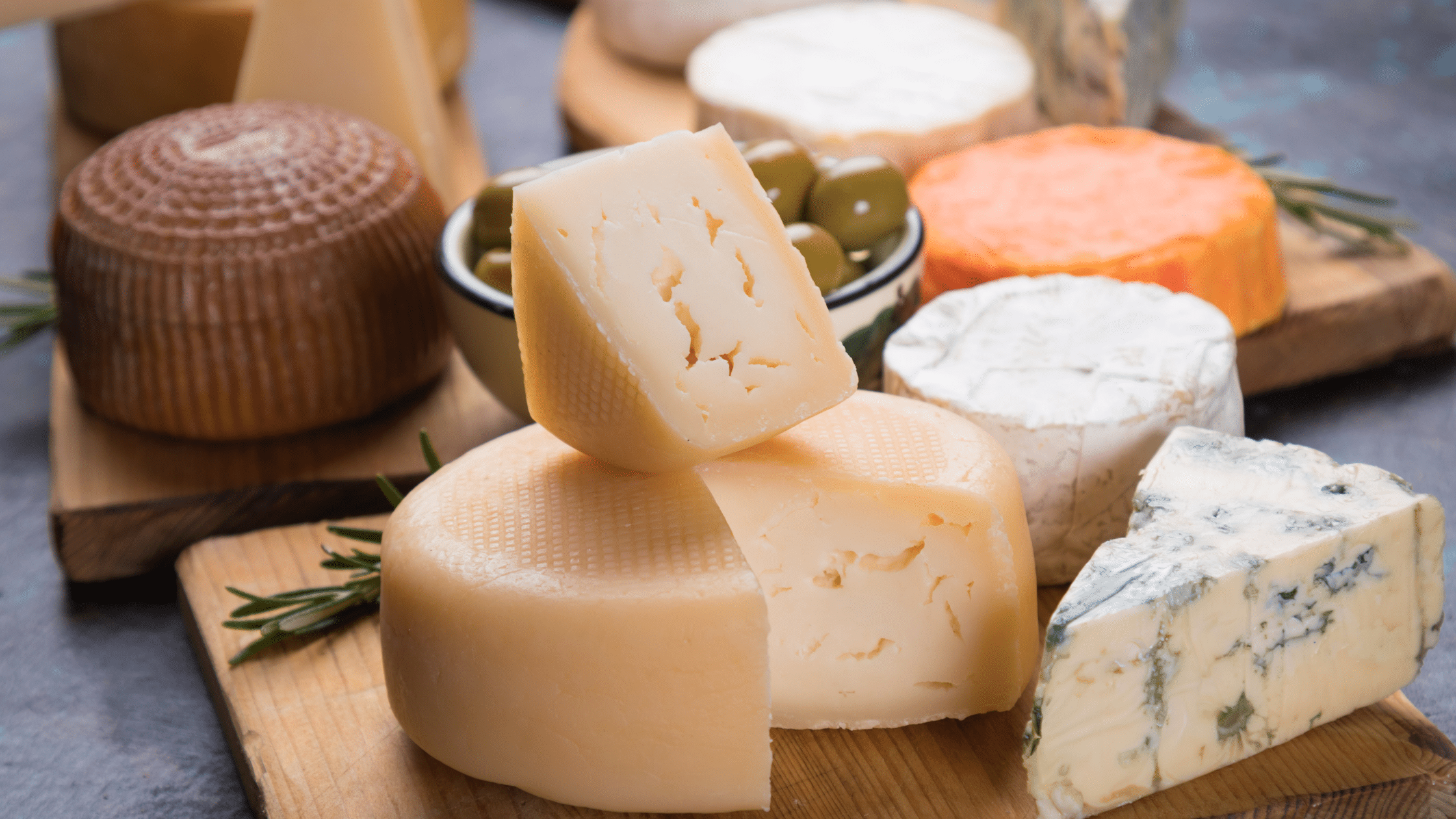
How to Choose Cheese for Pizza
How to choose cheese for pizza?
We cannot just pick a cheese that looks cool for a pizza. Besides being lazy, it can also change the way the pizza tastes! There are a lot of factors we have to consider.
But do not worry; you will quickly develop a chef’s intuition and look for these characteristics even without knowing.
When choosing cheese for pizza, it’s essential to consider a variety of factors to ensure the best flavor, texture, and overall experience.
These factors include the following:
- Type of milk,
- Moisture level
- Fat content, age
- Appearance
- Taste
- Stretchiness
- Meltiness
- Place of origin.
By carefully considering each of these aspects, you can select the perfect cheese to complement your pizza toppings and crust, elevating the dish to new heights. Understanding the nuances of different cheese types and their characteristics will enable you to make informed decisions and create delicious, crowd-pleasing pizzas.
Type of Milk
Milk is the foundation or base for any cheese, but the animal from which that milk comes drastically changes the way the cheese tastes.
- Cow’s milk – Milk of good quality is bland with a slightly sweet taste, very little odor, and a smooth, rich, creamy feel in the mouth.
- Goat’s milk – gets its flavor from the presence of short- and medium-chain fatty acids. These are fatty acids that give the milk its particular flavor. It’s that grassy, goaty, earthy flavor you get when eating goat cheese with a gamey flavor; contrary to cow’s milk, it does not have a sweet flavor.
- Sheep’s milk – The high butterfat content in sheep’s milk means sheep’s milk cheese is buttery and rich with a tangy flavor. Other typical sheep’s milk cheese flavors are nutty and gamy.
- Buffalo’s milk– is creamier, softer, and far more flavorful than cow milk, with a tanginess and depth of flavor that’s all it’s own.
The milk can affect how the cheese comes out, and you may have a specific preference for your pizza.
For example, some pizzas aim to be vegan or low-fat.
Mozzarella cheese can be made with almost any kind of milk, but you have to check the packaging to be sure.
Moisture Level
Moisture level plays an essential role since cheese is categorized by its firmness.
Higher moisture content results in a softer cheese, while lower moisture content results in a firmer cheese.
Accordingly, the moisture will affect the outcome of the pizza.
Moisture Level Content of Cheese for Pizza
| Classification | Percent moisture | Cheese texture | Examples |
| Low-Moisture | 13–34% | Very hard | Parmesan, Romano |
| Medium-Moisture | 34–45% | Hard/Semi-Hard | Cheddar, Swiss, Gouda, Edam |
| High-Moisture | 45–55% | Soft | Mozzarella, Blue, Brie |
| Very-High Moisture | 55–80% | Very soft | Cottage, Cream Cheese, Ricotta |
A cheese with higher moisture will melt easier.
On the other hand, you can use harder cheeses or low-moisture cheeses for shredded toppings.
Fat Content
If you are aiming for a low-fat pizza, then, of course, you have to pay attention to the fat content. While we all appreciate a great-tasting slice, our excess pounds are not always welcome!
Some guests might prefer low-fat cheese instead of the more conventional kinds. Also, many low-fat variants have less dairy content, which helps lactose intolerance.
In addition, there are also health benefits to cheeses with lower fat content, such as lower cholesterol levels.
Aging
Although overlooked by many chefs, the ripening of the cheese also matters. It is one of the most critical parts of the cheese production stage.
Aging cheese affects its appearance and flavor and smell and texture. The longer a cheese has aged, the sharper its taste.
We do not want a pizza overly sour, so make sure to choose a cheese that has aged just enough.
Appearance
Some might dismiss the appearance as a superficial concern, but it is a crucial component of the pizza!
A cheese that looks out of place will disrupt the visual appeal of the pizza and can make plating difficult. It helps to test if the cheese looks good when melted and sliced.
Taste
Of course, taste is one of the things you need to look for. The saltiness, sweetness, or sourness must go well with the other ingredients. If the flavor is incompatible with your desired taste, look for a different type.
Stretchability
The cheese’s stretchability should be considered if you want a pizza that looks good and meets expectations.
Some expect the cheese to produce that distinct “pull” when you grab a slice, adding to their satisfaction and overall experience. We all want that magic, so this might be something to think about!
Meltability
As the saying goes, time is money! The length of time a cheese melts can affect your preparation. If you want to prepare a pizza within a shorter time, choose a cheese that melts quickly while still tasting great.
Country of Origin
In some cases, the cheese’s origin also matters as other countries prepare their cheeses differently. Some last longer while refrigerated, while others have a shorter shelf life.
The taste can also vary depending on the variant.
Depending on your comfort, you can go out of your comfort zone and try some foreign kinds from time to time. Some great pizza recipes are born out of experimentation.
After all, we can only grow if we try out new things! Some countries have a good selection of cheeses, like Switzerland and France.
Of course, make sure to check your budget. It might not be practical to seek out imported cheese if you are trying a new recipe for the first time.
Tips on How to Choose Cheese for Pizza
- Don’t purchase mozzarella that has already been shredded. Instead, purchase mozzarella a block from your supermarket’s deli and keep it in the freezer.
Then, when you’re ready to use it, shred the mozzarella with a cheese grater for a food processor. The cheese taste will be creamier and richer if you use shredded deli mozzarella.
- Choose whole milk cheese. Whole milk mozzarella has a creamier texture (almost like cream cheese) and more taste than other milk mozzarella.
Because of the greater fat content level, the texture is creamier, and the taste is superior. It does, however, have one to two grams more fat per serving than other milk mozzarella.
If you use full-milk mozzarella, you won’t require as much cheese as you would if you used skim-milk mozzarella.
- Try other mozzarella versions, such as fresh mozzarella. This kind of mozzarella is the traditional Italian pizza cheese. Eight-ounce balls of fresh mozzarella are available in many supermarkets.
It’s commonly vacuum-sealed in a whey-filled container. This cheese cannot be shredded since it is soft and readily breaks apart. If you want to shred it, place it in the freezer for about 30 to 45 minutes, then grate it with a box grater.
It does have a short life span; once opened, fresh mozzarella has a limited shelf life and should be used within a week.
Types of Cheese for Pizza
When selecting cheese for pizza, consider the various categories, including fresh, soft, semi-soft, semi-firm, firm, and blue-veined cheeses. Fresh cheeses like Ricotta or Feta can add creaminess and tang, while soft cheeses such as Brie or Camembert bring a luxurious, velvety texture.
Semi-soft cheeses like Havarti or Gouda offer a balance of creaminess and meltability, while semi-firm options such as Provolone and Fontina provide a slightly more robust texture and nutty flavors. Firm cheeses, like Cheddar or Parmesan, contribute sharpness and a pleasant bite.
Lastly, blue-veined varieties like Gorgonzola or Roquefort add a bold, pungent dimension to gourmet pizza creations. Mixing and matching these cheese types can lead to intriguing flavor profiles and a delightful pizza experience.
Let’s look and them individually:
Fresh Cheese
Fresh cheese is a group of commonly used cheeses for cooking. Fresh cheeses are produced from fresh, non-aged, and non-pressed curds.
Fresh cheese varies in taste, with some possessing a velvety texture and a salty taste, while others are sweeter but with a moist exterior.
Fresh cheeses have a uniform consistency, although some variants are more acidic and quickly melt.
You can find most types of fresh cheese in any supermarket.
Creamy goat cheese is the most well-known, as it is used in pasta dishes like chicken alfredo or variants of carbonara. The crumbly but creamy feta cheese is often used for salads and soups, while soft mozzarella is a worldwide staple.
In short, fresh cheese is the one we turn to the most.
Soft Cheese
Soft cheeses have a pronounced flavor and odor, providing unique characteristics to most dishes.
Whenever we have drunk conversations during family gatherings or friendly reunions, there is often some soft cheese to go along with the wine. The taste of most soft cheeses is mild, but the texture is creamy and moist.
Some famous soft cheeses include blue cheese, buffalo mozzarella, burrata, and brie.
Semi-Soft Cheese
These cheeses are smoother, with almost no rind. They have a lot of moisture, and tastes vary depending on the kind. Some variants go well in sandwiches and other snacks like sliced American cheese.
Others, like Gouda and Provolone, appear in many platters. When used for baking, these cheeses melt wonderfully, although they can be harder to shred if used as-is.
Semi-Firm Cheese
These cheeses are pressed during their production. This process strips them of moisture, becoming firmer as they age. They are usually used for snacks and sandwiches, although some are also seen in cooked dishes like soups and casseroles.
Cheddar and Edam have known variants, although others are more popular in niche circles, such as Saint Nectaire cheese.
Semi-firm cheeses can be stored for long periods, lasting up to two months in the fridge when unopened. Even sliced or opened, they can last two to four weeks.
Firm or Hard Cheese
Firm or hard cheeses are pressed and cooked carefully to produce a concentrated and compact product. They are firm, although some variants have a grainy texture.
Many are grated when used as a garnish or additional spice, such as Parmesan and Romano. They also appear in soups, broths, and ham dishes.
Blue-Veined Cheese
These cheeses are fermented with a blue-green mold and injected inside through long needles. They have a strong flavor and a distinct appearance.
These cheeses are known in popular culture as good partners for crackers and fruits. Roquefort and Danish Blue have known variants.
Consider Application or Best Use
When choosing cheese for pizza, it’s essential to consider the application or best use of each cheese type. Selecting cheeses specifically suited for pizza ensures that the final product will have the desired flavor, texture, and meltability.
Avoid cheeses that are not appropriate for pizza, such as extremely hard, crumbly, or excessively oily cheeses, as they may not melt or combine well with other ingredients. By focusing on cheese types that enhance the overall pizza experience, you can create a delicious and satisfying dish that showcases the perfect harmony of flavors and textures.
An example of a cheese that is not suitable for pizza would be an extremely aged, crumbly cheese such as a very mature Parmesan or a dry, hard cheese like Mimolette. These cheeses have low moisture content and may not melt well when baked, resulting in a less appealing texture for your pizza. Additionally, their intense flavors could overpower other ingredients and disrupt the overall balance of flavors on your pizza.
Another example of cheese to avoid on pizza is a soft, highly processed cheese spread, like a commercial cheese spread or cheese product. These products often contain additives and stabilizers that can result in an undesirable texture and artificial taste, which is not ideal for pizza.
It’s also important to be cautious when using cheeses that are too liquidy for pizza, like Ricotta, as they may cause the pizza to become soggy. In such cases, using them sparingly or combining them with other, firmer cheeses can help maintain a desirable pizza texture.
When choosing cheese for pizza, it’s essential to consider cheeses that have good meltability, complement the other ingredients, and create a pleasant harmony of flavors and textures.
When to Add Cheese to Pizza
The timing of adding cheese to pizza can impact its texture, flavor, and overall appearance. Here’s a guide on when to add cheese, considering both before and after baking:
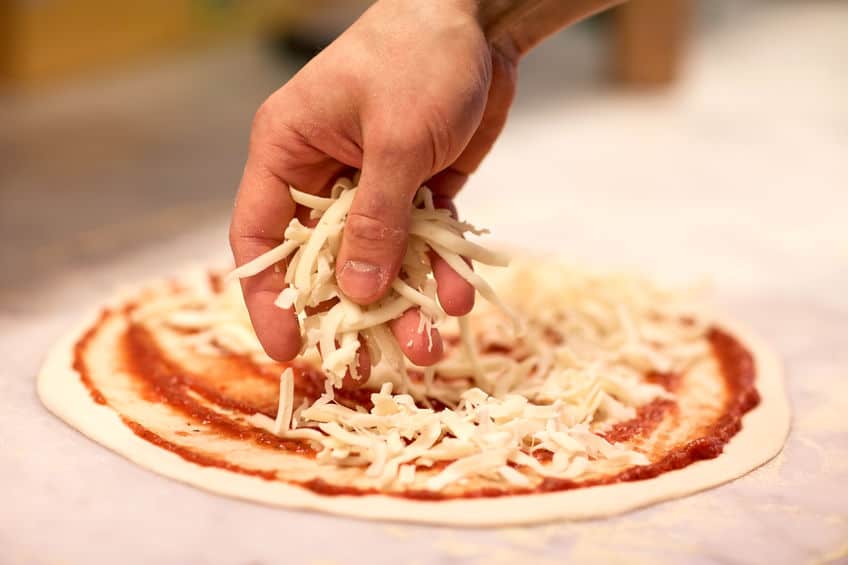
Before Baking
Cheese is typically put on the pizza before baking. It is usually placed after the tomato sauce but before toppings like meat and vegetables.
This order allows the cheese to get enough heat to melt and brown.
Mozzarella is often used, although some also like parmesan, cheddar, provolone, etc. However, some variants have cheese after the toppings.
Do not be afraid to experiment if you want!
After Baking
Many chefs overlook adding cheese after the pizza has finished in the oven. Although optional, they added more cheese as toppings can give the pizza a unique flavor.
Some grated parmesan works well, although some ricotta shavings can do the trick.
The key is finding the right cheese that does not overpower the rest of your toppings. You can use trial and error to find the perfect combination.
It might take a few tries to perfect it, so try to experiment on individual slices first.
Combining Different Cheeses for Pizza
Combining different cheeses for pizza can create a harmonious blend of flavors, textures, and meltability, resulting in a more complex and delicious dish.
Here are some tips and suggestions for combining cheeses for pizza:
Balance flavors
Pair strong-flavored cheeses, like blue cheese or aged Cheddar, with milder options, like Mozzarella or Fontina, to create a balanced taste. Combining cheeses with varying flavors can add depth and prevent one cheese from overpowering the others.
Consider meltability
Some cheeses, like Mozzarella and Provolone, melt well and create a smooth, gooey texture. Others, like Feta or Ricotta, retain their shape and texture during baking. Mixing cheeses with different melting properties can add variety to your pizza’s texture.
Experiment with textures
Pairing soft and creamy cheeses, like Brie or Camembert, with firmer options, like Cheddar or Parmesan, can create an interesting contrast in texture, making each bite more satisfying.
Complement toppings
Choose cheese combinations that enhance the flavors of your pizza toppings. For example, a combination of Gorgonzola and Mozzarella can complement the sweetness of caramelized onions or figs, while Provolone and Parmesan might enhance the flavors of pepperoni or sausage.
Ratios matter
When combining cheeses, consider the ratio of each cheese to achieve the desired flavor balance. For example, use a higher proportion of mild cheese like Mozzarella and a smaller amount of strong-flavored cheese like Gorgonzola to prevent overpowering the other ingredients.
Layering
The order in which you layer the cheeses can impact the final result. You might want to place a base layer of Mozzarella and then add smaller amounts of other cheeses on top for a more pronounced flavor profile.
Don’t be afraid to experiment with different cheese combinations and discover new favorites. The possibilities are endless, and you might be surprised by the unique flavor profiles you can create by combining various kinds of cheese on your pizza.
Best Cheese for Pizza
The best cheese for pizza depends on personal preference and the desired flavor profile. However, some popular choices include:
- Mozzarella: This is the most common and traditional cheese used for pizza due to its mild flavor, excellent stretchiness, and meltability. Fresh mozzarella or low-moisture mozzarella are both great options.
- Provolone: A semi-firm cheese with a subtle smoky flavor that melts well, Provolone is often used in combination with mozzarella for a more complex taste.
- Cheddar: With its sharp, tangy flavor, Cheddar can add depth to your pizza. It melts well, making it suitable for various pizza styles.
- Gouda: A semi-soft cheese with a creamy texture and a slightly sweet, nutty flavor. Gouda can be an interesting alternative or addition to traditional pizza cheese.
- Fontina: This semi-firm cheese offers a mild, nutty flavor and excellent meltability. It can be used alone or combined with other cheeses for a richer taste.
- Parmesan: A firm, aged cheese with a granular texture and sharp, salty flavor, Parmesan is often grated over pizza after baking as a finishing touch.
- Gorgonzola: A blue-veined cheese with a bold, pungent flavor, Gorgonzola can add a gourmet touch to your pizza. It’s often used in combination with milder cheeses to balance the intensity.
Ultimately, the best cheese for your pizza depends on your personal taste and the specific flavors you want to achieve. Experiment with different cheese combinations to discover your favorite blend.
Best Mozarella Cheese for Pizza
When you are wondering how to choose cheese for pizza and have several mozzarella options, here’s what you need to look for.
Low-Moisture Mozzarella is the best mozzarella cheese for pizza; it has a creamy taste and a firmer texture, which makes it the ideal cheese for shredding. Sprinkle some on your next homemade pizza.
On top of that, low-moisture mozzarella also has great meltability. It stretches well but remains dry enough to go well with the crust.
On the topic of consistency, low-moisture mozzarella also shreds much easier. It has a very firm consistency, putting it above other variants. The firmness allows it to have a distinct stretchability when melting occurs.
Unlike fresh mozzarella, which starts to deteriorate in taste after a few days, the flavor of low-moisture mozzarella stays intact in the fridge.
The taste is also top-notch and will leave many guests satisfied. It can also be easily transported and is often sold in bulk for lower prices. No wonder this one stood out from the pack out of the many kinds of cheese in the world.
Many pizzerias built their way to the top by mixing and matching their ingredients, including cheese. The principle is to find a mix that speaks well with your preferences and goals as a chef.
Related Questions
What is the Best Stretchy Cheese for a Pizza
The undisputed king of stretchy cheese for pizza is mozzarella. Low-Moisture mozzarella has the ideal moisture, elasticity, and fat content balance for meltability.
Can You Use any Kind of Cheese for Pizza?
You can use almost any kind of cheese for pizza. However, you need to make what taste and texture you want to add to your pizza before choosing the kind of cheese to use.
Check our 30 Different Cheeses for Pizza article to learn more about the different types of cheeses and how to use them for pizza.
Here are the Cheeses the Pros at Homemade Pizza Pro Use and Recommend
The Last Slice
We hope you are now a PRO! on how to choose cheese for pizza.
Do not expect to perfect your recipes right away. Choosing the right cheese is one step in this journey to become the next best pizza mastermind.
Whatever the case, do not lose faith while you go on your pizza-making journey.
Empires do not happen overnight, even ones built on pizza.
What you need is determination and passion, alongside some good low-moisture mozzarella.
Additional Cheese Resources
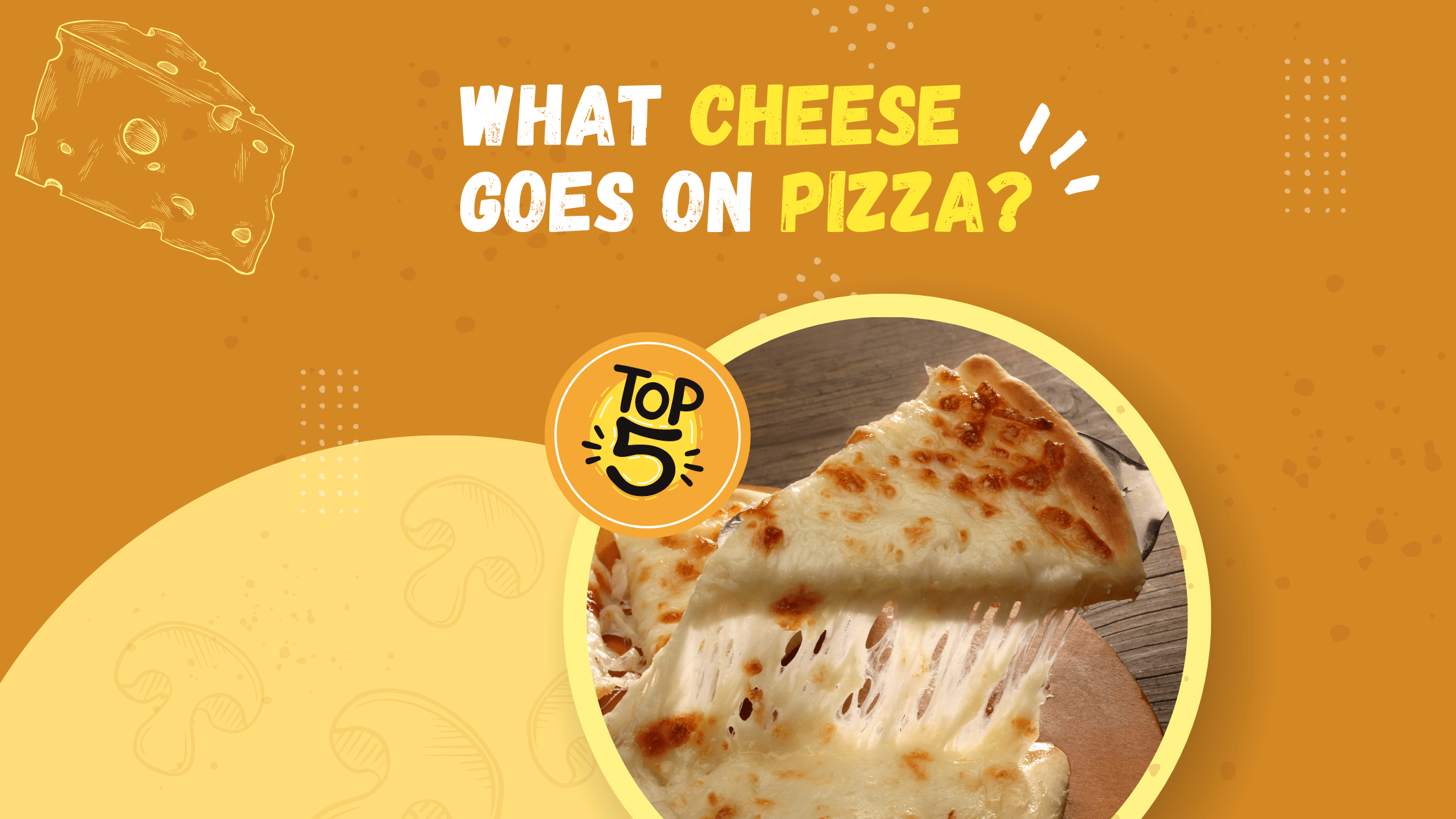
What Cheese Goes on Pizza? Find the Top Cheeses for Pizza
the PROs
What Cheese Goes on Pizza? you asked. What cheese goes on pizza? – a question as old as the tradition …

Is Cheese a Pizza Topping? Find the PRO Answer
the PROs
If you’ve ever ordered a pizza, you’ve likely wondered, is cheese a pizza topping? or part of the pizza. There’s …

Aging Cheese: The Ultimate Guide to Upscale Your Skills
the PROs
Aging Cheese Have you ever tried aging cheese? As you may already know, cheese is one of the most universally …
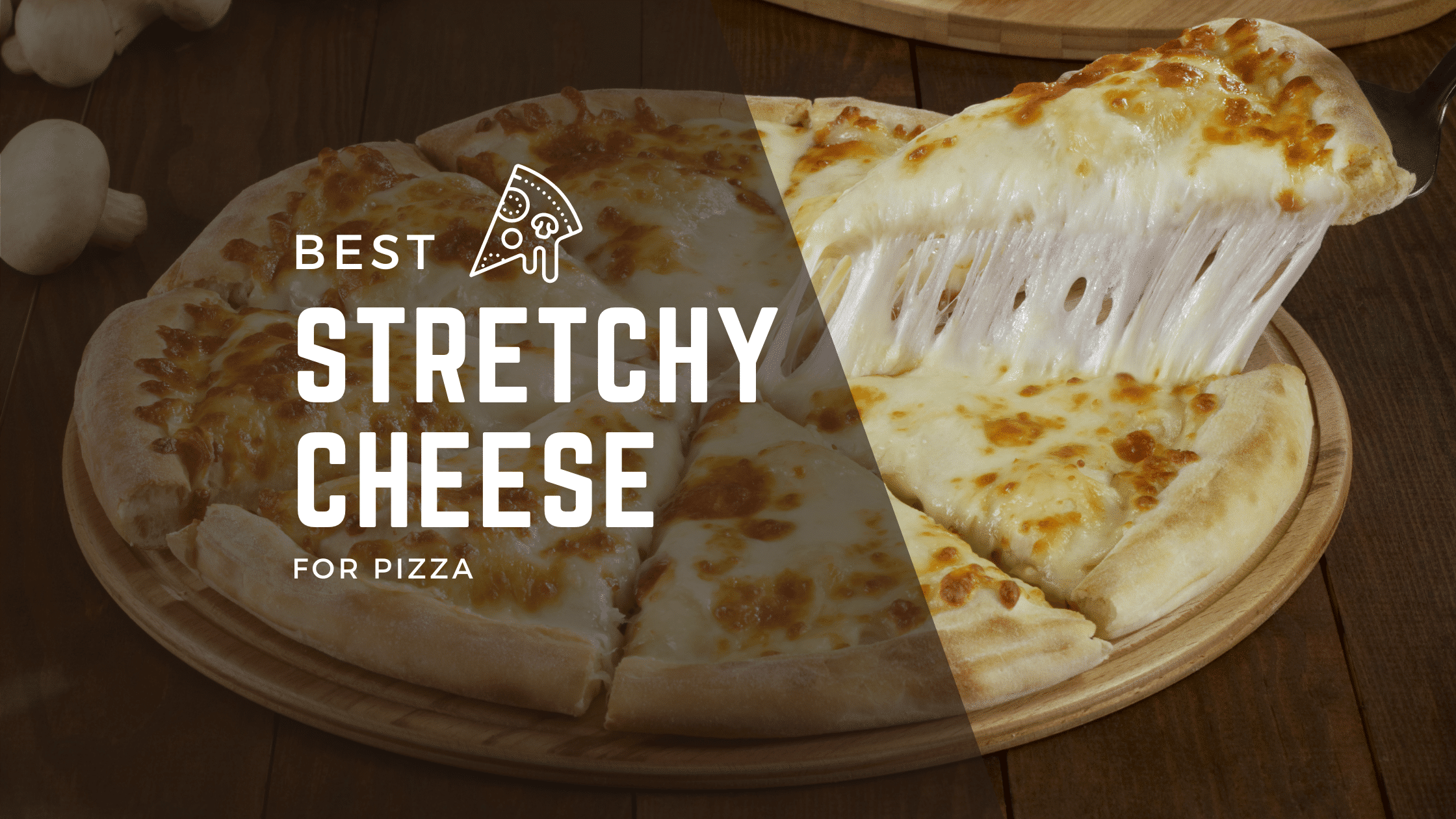
Best Stretchy Cheese for a Pizza – (Top 7 Stringy and Gooey Cheeses You Need to Try)
the PROs
Stretching all the way from the tray to our mouths, cheese is known to be one of the top favorite …

Master the Art of Melting Mozzarella Cheese: Tips and Tricks from the Pros
the PROs
Are you ready to embark on an epic journey to transform your homemade pizza game with the ultimate secret to …
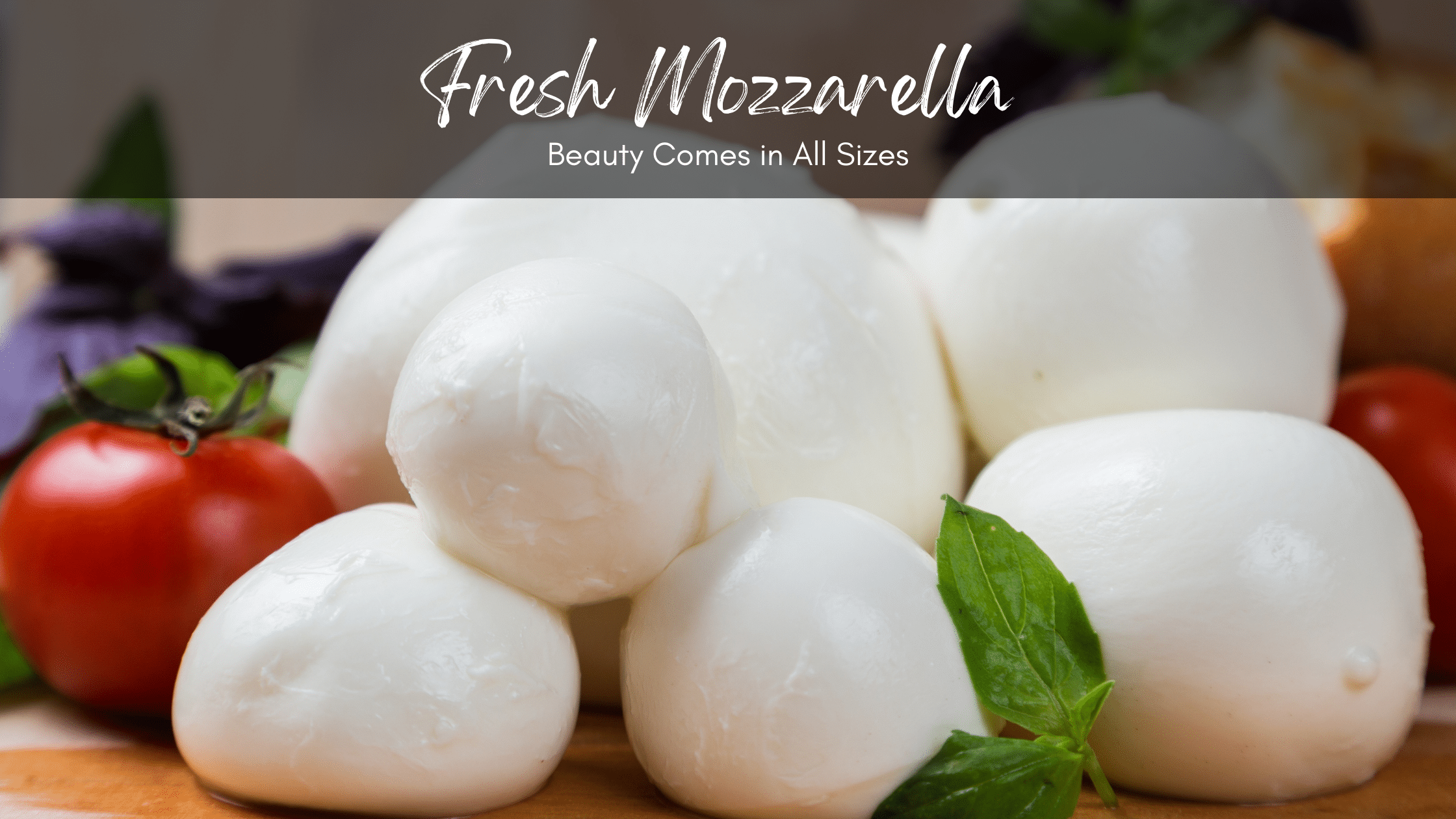
Mozzarella Sizes – (Why Fresh Small Balls are the Best)
the PROs
Are you confused with all the different mozzarella ball sizes? Have you ever visited the supermarket and looked at all …
Enjoy!
Not a PRO? Not a Problem!
Take a pizza class to bring your pizza skills to the next level,
so you can be a PRO!
Related Posts

Costco Pizza Delivery: Find How You Can Get It Now!
the PROs
People go to Costco’s food court for many different reasons, but the cheesy slice of pizza they serve is among …

Pizza for Beginners: Don’t Buy Pizza, Make It! Here’s How to Get Started!
the PROs
You have this idea that you want to make pizza at home as opposed to ordering it, but where do you start? Don’t worry! Here you will find answers and directions to all your questions.

Pizza Toppings Under Cheese or Over Cheese? [Why the Order Matters]
the PROs
Is Pizza Cheese on Top or Bottom? Hey pizza lovers, are you wondering if you should layer pizza toppings under …
Newsletter
Subscribe to our Recipe of the Week newsletter and receive our partners’ latest recipes, tips, and discount offers.
Keep in Touch!


